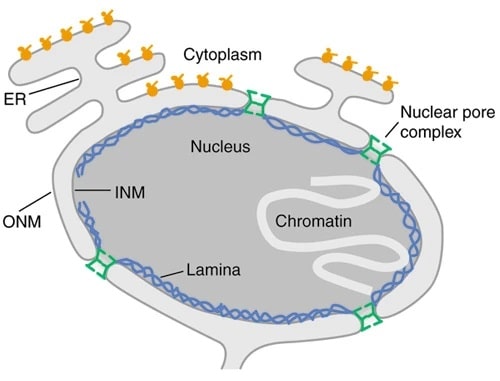Every living cell has a centrally regulating and a dusky structure called a “nucleus“.
The nucleus function is essential for a cell’s everyday survival and multiplication.
The cells with a well-formed nucleus are called eukaryotic cells.
The cells lacking a clearly defined nucleus are called prokaryotic cells like bacteria.
However, even in higher animals, the nucleus is absent in red blood cells (RBCs) and hence these cells are called corpuscles.
The nucleus is believed to have central control over the entire cell and other cell organelles throughout its life span. It contains large amounts of DNA and chromatin material which is the genes.
Nucleus structure
- The nucleus appears as a spherical body when viewed under a microscope.
- But it can also have other shapes based on cell requirements and functions.
- It is the largest organelle of the cell visible under the microscope.

- It has a nuclear double membrane encircling to enclose the entire nuclear contents.
1. As shown in the picture, there is an outer nuclear membrane (ONM) and inner nuclear membrane (INM).
2. It also has nucleoplasm (i.e., fluid matrix of the nucleus), DNA, chromosomes, and nucleolus. There are few nuclear pores on the membrane which connect with the external cytoplasm.
3. On its surface, endoplasmic reticulum bodies are attached but they are separate cell organelles.
Cell Nucleus function & importance
Storage of genetic information:
- The nucleus has the genetic material that helps retain the characters from parents to offspring. This occurs for generations together.
Cell division
- It is an important process. It initiates the process by DNA replication, then nucleus, and also cell membrane divisions.
- It is involved in both mitotic and meiotic cell divisions.
Gene replication
- The genes control the characters of the living organisms. They undergo replication to help the reproduction of the cell.
- The genes first reproduce to give two identical sets of genes; then, the cell splits by a unique process called mitosis to form two daughter cells, each of which receives one of the two sets of DNA genes.
Protein synthesis
- Majorly nucleus is involved in protein synthesis required for cell physiology, growth, multiplication, death, etc.
- It forms the mRNA by which it guides the protein synthesis
- The genes by transcription determine the characteristics of the cell’s proteins, including the structural proteins and the intracellular enzymes that control cytoplasmic and nuclear activities.
Signal mechanism
- Some chemicals and drugs on the genes in the nucleus to produce changes.
- The nucleus help in that signal communication by receptors on the nuclear membrane.
- Nuclear receptors transmit the signal from the surface of the nucleus to the genes in it.
- Steroids and other drugs act by regulating the genes in the nucleus by fixing onto the receptors on the nuclear membrane.
Transfer of materials
- The pores on the nucleus help transfer formed messenger ribonucleic acids (mRNA) from the nucleus into the cytoplasm.
- These mRNA’s sit on the surface of the endoplasmic reticulum to guide the formation of proteins.
- The amino acids and other substances required for DNA and RNA formation move from the cytoplasm into the nucleus.
A single human cell nucleus contains all the information necessary to constitute a whole human being. On the other hand, a single human brain doesn’t contain information anywhere near sufficient to constitute a perfect society (the human super-organism)